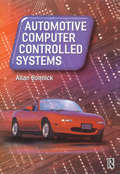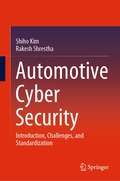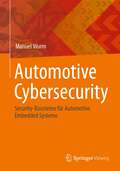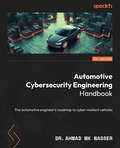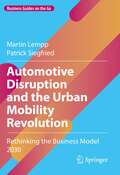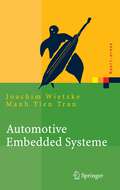- Table View
- List View
The Automotive Body: Volume II: System Design (Mechanical Engineering Series)
by L. Morello Lorenzo Rosti Rossini Giuseppe Pia Andrea Tonoli“The Automotive Body” consists of two volumes. The first volume produced the needful cultural background on the body; it described the body and its components in use on most kinds of cars and industrial vehicles: the quantity of drawings that are presented allows the reader to familiarize with the design features and to understand functions, design motivations and fabrication feasibility, in view of the existing production processes. The purpose of this second volume is to explain the links which exist between satisfying the needs of the customer (either driver or passenger) and the specifications for vehicle design, and between the specifications for vehicle system and components. For this study a complete vehicle system must be considered, including, according to the nature of functions that will be discussed, more component classes than considered in Volume I, and, sometimes, also part of the chassis and the powertrain. These two books about the vehicle body may be added to those about the chassis and are part of a series sponsored by ATA (the Italian automotive engineers association) on the subject of automotive engineering; they follow the first book, published in 2005 in Italian only, about automotive transmission.They cover automotive engineering from every aspect and are the result of a five-year collaboration between the Polytechnical University of Turin and the University of Naples on automotive engineering.
The Automotive Body Manufacturing Systems and Processes
by Mohammed A. OmarA comprehensive and dedicated guide to automotive production lines, The Automotive Body Manufacturing Systems and Processes addresses automotive body processes from the stamping operations through the final assembly activities. To begin, it discusses current metal forming practices, including stamping engineering, die development, and dimensional validation, and new innovations in metal forming, such as folding based forming, super-plastic, and hydro forming technologies. The first section also explains details of automotive spot welding (welding lobes), arc welding, and adhesive bonding, in addition to flexible fixturing systems and welding robotic cells. Guiding readers through each stage in the process of automotive painting, including the calculations needed to compute the number of applicators and paint consumption based on vehicle dimensions and demand, along with the final assembly and automotive mechanical fastening strategies, the book's systematic coverage is unique. The second module of the book focuses on the layout strategies of the automotive production line. A discussion of automotive aggregate planning and master production scheduling ensures that the reader is familiar with operational aspects. The book also reviews the energy emissions and expenditures of automotive production processes and proposes new technical solutions to reduce environmental impact. Provides extensive technical coverage of automotive production processes, discussing flexible stamping, welding and painting lines Gives complete information on automotive production costing as well as the supplier selection process Covers systems from the operational perspective, describing the aggregate and master production planning Details technical aspects of flexible automotive manufacturing lines Methodically discusses the layout and location strategies of automotive manufacturing systems to encompass the structural elements Features topic-related questions with answers on a companion website
The Automotive Body Manufacturing Systems and Processes
by Mohammed A. OmarA comprehensive and dedicated guide to automotive production lines, The Automotive Body Manufacturing Systems and Processes addresses automotive body processes from the stamping operations through the final assembly activities. To begin, it discusses current metal forming practices, including stamping engineering, die development, and dimensional validation, and new innovations in metal forming, such as folding based forming, super-plastic, and hydro forming technologies. The first section also explains details of automotive spot welding (welding lobes), arc welding, and adhesive bonding, in addition to flexible fixturing systems and welding robotic cells. Guiding readers through each stage in the process of automotive painting, including the calculations needed to compute the number of applicators and paint consumption based on vehicle dimensions and demand, along with the final assembly and automotive mechanical fastening strategies, the book's systematic coverage is unique. The second module of the book focuses on the layout strategies of the automotive production line. A discussion of automotive aggregate planning and master production scheduling ensures that the reader is familiar with operational aspects. The book also reviews the energy emissions and expenditures of automotive production processes and proposes new technical solutions to reduce environmental impact. Provides extensive technical coverage of automotive production processes, discussing flexible stamping, welding and painting lines Gives complete information on automotive production costing as well as the supplier selection process Covers systems from the operational perspective, describing the aggregate and master production planning Details technical aspects of flexible automotive manufacturing lines Methodically discusses the layout and location strategies of automotive manufacturing systems to encompass the structural elements Features topic-related questions with answers on a companion website
The Automotive Chassis: Volume 2: System Design (Mechanical Engineering Series)
by Giancarlo Genta L. MorelloThis work serves as a reference concerning the automotive chassis, i.e. everything that is inside a vehicle except the engine and the body. It is the result of a decade of work mostly done by the FIAT group, who supplied material, together with other automotive companies, and sponsored the work. The first volume deals with the design of automotive components and the second volume treats the various aspects of the design of a vehicle as a system.
The Automotive Chassis: Volume 1: Components Design (Mechanical Engineering Series)
by Giancarlo Genta L. MorelloThe aim of the book is to be a reference book in automotive technology, as far as automotive chassis (i.e. everything that is inside a vehicle except the engine and the body) is concerned. The book is a result of a decade of work heavily sponsored by the FIAT group (who supplied material, together with other automotive companies, and sponsored the work). The first volume deals with the design of automotive components and the second volume treats the various aspects of the design of a vehicle as a system.
The Automotive Chassis: Volume 2: System Design (Mechanical Engineering Series)
by Giancarlo Genta Lorenzo MorelloThis textbook draws on the authors’ experience gained by teaching courses for engineering students on e.g. vehicle mechanics, vehicle system design, and chassis design; and on their practical experience as engineering designers for vehicle and chassis components at a major automotive company. The book is primarily intended for students of automotive engineering, but also for all technicians and designers working in this field. Other enthusiastic engineers will also find it to be a useful technical guide.The present volume (The Automotive Chassis – Volume 2: System Design) focuses on the automotive chassis as a system, providing readers with the knowledge needed to integrate the individual components described in Volume 1 in a complex system that satisfies customers’ expectations. Special emphasis is given to factors influencing system performance, including: - the influence of the powertrain on vehicle performance. Conventional, hybrid and electric powertrains are considered; - factors influencing vehicles’ handling performance; - factors influencing vehicles’ comfort performance; and - factors influencing vehicles’ stability and strategies for accident avoidance (active safety).In addition, this second volume thoroughly covers topics that are usually neglected in other books about the automotive chassis, such as: - the basics of vehicle aerodynamics; - internal combustion engines, electric motors and batteries; and - mathematical modeling tools.This thoroughly revised second edition has been updated to reflect the latest advances in electric and hybrid vehicles, electronic control systems and autonomous driving.
The Automotive Chassis: Volume 1: Components Design (Mechanical Engineering Series)
by Giancarlo Genta Lorenzo MorelloThis textbook draws on the authors’ experience gained by teaching courses for engineering students on e.g. vehicle mechanics, vehicle system design, and chassis design; and on their practical experience as engineering designers for vehicle and chassis components at a major automotive company.The book is primarily intended for students of automotive engineering, but also for all technicians and designers working in this field. Other enthusiastic engineers will also find it to be a useful technical guide.The present volume (The Automotive Chassis – Volume 1: Component Design) focuses on automotive chassis components, such as:• the structure, which is usually a ladder framework and supports all the remaining components of the vehicle;• the suspension for the mechanical linkage of the wheels;• the wheels and tires;• the steering system;• the brake system; and• the transmission system, used to apply engine torque to the driving wheels.This thoroughly revised and updated second edition presents recent developments, particularly in brake, steering, suspension and transmission subsystems. Special emphasis is given to modern control systems and control strategies.
Automotive Chassis Engineering
by David C Barton John D FieldhouseWritten for students and practicing engineers working in automotive engineering, this book provides a fundamental yet comprehensive understanding of chassis systems and requires little prior knowledge on the part of the reader. It presents the material in a practical and realistic manner, using reverse engineering as a basis for examples to reinforce understanding of the topics. The specifications and characteristics of vehicles currently on the market are used to exemplify the theory’s application, and care is taken to connect the various topics covered, so as to clearly demonstrate their interrelationships.The book opens with a chapter on basic vehicle mechanics, which include the forces acting on a vehicle in motion, assuming a rigid body. It then proceeds to a chapter on steering systems, which provides readers with a firm understanding of the principles and forces involved under static and dynamic loading. The next chapter focuses on vehicle dynamics by considering suspension systems—tyres, linkages, springs, dampers etc. The chapter on chassis structures and materials includes analysis tools (typically, finite element analysis) and design features that are used to reduce mass and increase occupant safety in modern vehicles. The final chapter on Noise, Vibration and Harshness (NVH) includes a basic overview of acoustic and vibration theory and makes use of extensive research investigations and practical experience as a means of addressing NVH issues. In all subject areas the authors take into account the latest trends, anticipating the move towards electric vehicles, on-board diagnostic monitoring, active systems and performance optimisation. The book features a number of worked examples and case studies based on recent research projects. All students, including those on Master’s level degree courses in Automotive Engineering, and professionals in industry who want to gain a better understanding of vehicle chassis engineering, will benefit from this book.
Automotive Chassis Engineering
by David C. Barton John D. FieldhouseWritten for students and practising engineers working in automotive engineering, this book provides a fundamental yet comprehensive understanding of chassis systems and requires little prior knowledge on the part of the reader. It presents the material in a practical and realistic manner, using reverse engineering as a basis for examples to reinforce understanding of the topics. The specifications and characteristics of vehicles currently on the market are used to exemplify the theory’s application, and care is taken to connect the various topics covered, so as to clearly demonstrate their interrelationships. This second edition is fully updated and revised throughout and includes a new chapter on vehicle deceleration behaviour. The book opens with a chapter on basic vehicle mechanics, which includes the forces acting on a vehicle in motion, assuming a rigid body. The new chapter on vehicle deceleration behaviour introduces the basic concepts of a conventional foundation braking system before considering means of optimising the deceleration performance of any wheel-braked vehicle based on the tyre-road adhesion characteristics. The next chapter focuses on vehicle dynamics by considering suspension systems and how the important components of the system, the tyres, linkages, springs, dampers, etc., interact to give the required peformance characteristics for the vehicle. The book then proceeds to a chapter on steering systems, which provides readers with a firm understanding of the principles and forces involved under static and dynamic loading. The chapter on chassis structures and materials outlines analysis tools (typically, finite element analysis) and design features that are used to reduce mass and increase occupant safety in modern vehicles. The final chapter on noise, vibration and harshness (NVH) includes a basic overview of acoustic and vibration theory and makes use of extensive research investigations and practical experience asa means of addressing NVH issues. In all subject areas, the authors take into account the latest trends, anticipating the move towards electric vehicles, on-board diagnostic monitoring, active systems and performance optimisation. The book features a number of worked examples and case studies based on recent research projects. All students, including those on Master level degree courses in automotive engineering, and professionals in industry who want to gain a better understanding of vehicle chassis engineering, will benefit from this book.
Automotive Computer Controlled Systems
by Allan Bonnick'Automotive Computer Controlled Systems' explains the fundamental principles of engineering that lie behind the operation of vehicle electronic systems. Having obtained this knowledge, the reader will be able to make full use of the diagnostic equipment which is currently available. The book builds on the concepts contained in Vehicle Electronic Systems and Fault Diagnosis and gives clear steps to fault diagnosis and subsequent repair of the vehicle's electronic systems. The author discusses electronics only within the context of the vehicle systems under consideration, and thus keeps theory to a minimum.Allan Bonnick has written articles for several transport/vehicle journals and carries out consultancy work for the Institute of Road Transport Engineers. In addition, he has had many years teaching experience and is ideally placed to write this informative guide.
Automotive Computer Controlled Systems
by Allan Bonnick'Automotive Computer Controlled Systems' explains the fundamental principles of engineering that lie behind the operation of vehicle electronic systems. Having obtained this knowledge, the reader will be able to make full use of the diagnostic equipment which is currently available. The book builds on the concepts contained in Vehicle Electronic Systems and Fault Diagnosis and gives clear steps to fault diagnosis and subsequent repair of the vehicle's electronic systems. The author discusses electronics only within the context of the vehicle systems under consideration, and thus keeps theory to a minimum.Allan Bonnick has written articles for several transport/vehicle journals and carries out consultancy work for the Institute of Road Transport Engineers. In addition, he has had many years teaching experience and is ideally placed to write this informative guide.
Automotive Control: Modeling and Control of Vehicles (ATZ/MTZ-Fachbuch)
by Rolf IsermannThe introduction of mechatronic components for the powertrain, steering and braking systems opens the way to automatic driving functions. Together with internal and environmental sensors, various driver assistance systems are going to be developed for improving driving comfort and safety. Automatic driving control functions suppose a well-designed vehicle behavior. In order to develop and implement the software-based control functions mathematical vehicle models for the stationary and dynamic behavior are required. The book first introduces basic theoretically derived models for the tire traction and force transfer, the longitudinal, lateral, roll and pitch dynamic behavior and related components, like suspensions, steering systems and brakes. These models have to be tailored to allow an identification of the many unknown parameters during driving, also in dependence of different road conditions, velocity and vehicle load. Based on these mathematical models drive dynamic control systems are developed for semi-active and active suspensions, hydraulic and electromechanical brakes including ABS, traction and steering control. Then driver assistance systems like adaptive cruise control (ACC), electronic stability control (ESC), electronic course control and anti-collision control systems are considered. The anti-collision systems are designed and tested for emergency braking, emergency steering and avoiding of overtaking accidents. The book is dedicated to automotive engineers as well as to graduate students of mechanical, electrical and mechatronic engineering and computer science.
Automotive Control Systems: For Engine, Driveline, and Vehicle
by Uwe Kiencke Lars NielsenWritten by two of the most respected, experienced and well-known researchers and developers in the field (e.g., Kiencke worked at Bosch where he helped develop anti-breaking system and engine control; Nielsen has lead joint research projects with Scania AB, Mecel AB, Saab Automobile AB, Volvo AB, Fiat GM Powertrain AB, and DaimlerChrysler. Reflecting the trend to optimization through integrative approaches for engine, driveline and vehicle control, this valuable book enables control engineers to understand engine and vehicle models necessary for controller design and also introduces mechanical engineers to vehicle-specific signal processing and automatic control. Emphasis on measurement, comparisons between performance and modelling, and realistic examples derive from the authors’ unique industrial experience . The second edition offers new or expanded topics such as diesel-engine modelling, diagnosis and anti-jerking control, and vehicle modelling and parameter estimation. With only a few exceptions, the approaches
Automotive Cyber Security: Introduction, Challenges, and Standardization
by Shiho Kim Rakesh ShresthaThis book outlines the development of safety and cybersecurity, threats and activities in automotive vehicles. This book discusses the automotive vehicle applications and technological aspects considering its cybersecurity issues. Each chapter offers a suitable context for understanding the complexities of the connectivity and cybersecurity of intelligent and autonomous vehicles. A top-down strategy was adopted to introduce the vehicles’ intelligent features and functionality. The area of vehicle-to-everything (V2X) communications aims to exploit the power of ubiquitous connectivity for the traffic safety and transport efficiency. The chapters discuss in detail about the different levels of autonomous vehicles, different types of cybersecurity issues, future trends and challenges in autonomous vehicles. Security must be thought as an important aspect during designing and implementation of the autonomous vehicles to prevent from numerous security threats and attacks. The book thus provides important information on the cybersecurity challenges faced by the autonomous vehicles and it seeks to address the mobility requirements of users, comfort, safety and security. This book aims to provide an outline of most aspects of cybersecurity in intelligent and autonomous vehicles. It is very helpful for automotive engineers, graduate students and technological administrators who want to know more about security technology as well as to readers with a security background and experience who want to know more about cybersecurity concerns in modern and future automotive applications and cybersecurity. In particular, this book helps people who need to make better decisions about automotive security and safety approaches. Moreover, it is beneficial to people who are involved in research and development in this exciting area. As seen from the table of contents, automotive security covers a wide variety of topics. In addition to being distributed through various technological fields, automotive cybersecurity is a recent and rapidly moving field, such that the selection of topics in this book is regarded as tentative solutions rather than a final word on what exactly constitutes automotive security. All of the authors have worked for many years in the area of embedded security and for a few years in the field of different aspects of automotive safety and security, both from a research and industry point of view.
Automotive Cybersecurity: Security-Bausteine für Automotive Embedded Systeme
by Manuel WurmDie aktuellen technologischen Veränderungen, allen voran die Digitalisierung, die Vernetzung von Verkehrssystemen und das Autonome Fahren, schaffen einerseits neue Mobilitätslösungen, andererseits rücken dadurch Fahrzeuge und die Automotive Infrastruktur als zunehmend attraktive Angriffsziele in den Fokus von Hackern und Cyberkriminellen. Die höhere Komplexität elektronischer Systeme hat eine größere Angriffsoberfläche zur Folge. Ein strukturierter und ganzheitlicher Ansatz macht diese Herausforderung beherrschbar. Dieses Buch verschafft dem Leser einen Überblick über die für ein umfassendes Securitykonzept erforderlichen Security-Bausteine. Die detaillierte Darstellung verschiedener Security-Mechanismen beschreibt einerseits wie Fahrzeugsysteme vor bestimmten Angriffen geschützt werden und macht andererseits deutlich, welche Herausforderungen und Abhängigkeiten deren Implementierung in ein Automotive Deeply-Embedded System mit sich bringt.
Automotive Cybersecurity Engineering Handbook: The automotive engineer's roadmap to cyber-resilient vehicles
by Dr. Ahmad NasserAccelerate your journey of securing safety-critical automotive systems through practical and standard-compliant methodsKey FeaturesUnderstand how automotive systems can become vulnerable to cyberattacksApply security controls to all vehicle layers for mitigating cybersecurity risksFind out how systematic secure engineering mitigates cyber risks while ensuring compliancePurchase of the print or Kindle book includes a free PDF eBookBook DescriptionReplete with exciting challenges, automotive cybersecurity is an emerging domain, and cybersecurity is a foundational enabler for current and future connected vehicle features. This book addresses the severe talent shortage faced by the industry in meeting the demand for building cyber-resilient systems by consolidating practical topics on securing automotive systems to help automotive engineers gain a competitive edge. The book begins by exploring present and future automotive vehicle architectures, along with relevant threats and the skills essential to addressing them. You’ll then explore cybersecurity engineering methods, focusing on compliance with existing automotive standards while making the process advantageous. The chapters are designed in a way to help you with both the theory and practice of building secure systems while considering the cost, time, and resource limitations of automotive engineering. The concluding chapters take a practical approach to threat modeling automotive systems and teach you how to implement security controls across different vehicle architecture layers. By the end of this book, you'll have learned effective methods of handling cybersecurity risks in any automotive product, from single libraries to entire vehicle architectures.What you will learnGet to grips with present and future vehicle networking technologiesExplore basic concepts for securing automotive systemsDiscover diverse approaches to threat modeling of systemsConduct efficient threat analysis and risk assessment (TARA) for automotive systems using best practicesGain a comprehensive understanding of ISO/SAE 21434's cybersecurity engineering approachImplement cybersecurity controls for all vehicle life cyclesMaster ECU-level cybersecurity controlsWho this book is forIf you’re an engineer wondering where to get started in the field of automotive cybersecurity or trying to understand which security standards apply to your product and how, then this is the book for you. This book is also for experienced engineers looking for a practical approach to automotive cybersecurity development that can be achieved within a reasonable time frame while leveraging established safety and quality processes. Familiarity with basic automotive development processes across the V-model will help you make the most of this book.
Automotive Cybersecurity Engineering Handbook: The automotive engineer's roadmap to cyber-resilient vehicles
by Dr. Ahmad NasserAccelerate your journey of securing safety-critical automotive systems through practical and standard-compliant methodsKey FeaturesUnderstand how automotive systems can become vulnerable to cyberattacksApply security controls to all vehicle layers for mitigating cybersecurity risksFind out how systematic secure engineering mitigates cyber risks while ensuring compliancePurchase of the print or Kindle book includes a free PDF eBookBook DescriptionReplete with exciting challenges, automotive cybersecurity is an emerging domain, and cybersecurity is a foundational enabler for current and future connected vehicle features. This book addresses the severe talent shortage faced by the industry in meeting the demand for building cyber-resilient systems by consolidating practical topics on securing automotive systems to help automotive engineers gain a competitive edge. The book begins by exploring present and future automotive vehicle architectures, along with relevant threats and the skills essential to addressing them. You’ll then explore cybersecurity engineering methods, focusing on compliance with existing automotive standards while making the process advantageous. The chapters are designed in a way to help you with both the theory and practice of building secure systems while considering the cost, time, and resource limitations of automotive engineering. The concluding chapters take a practical approach to threat modeling automotive systems and teach you how to implement security controls across different vehicle architecture layers. By the end of this book, you'll have learned effective methods of handling cybersecurity risks in any automotive product, from single libraries to entire vehicle architectures.What you will learnGet to grips with present and future vehicle networking technologiesExplore basic concepts for securing automotive systemsDiscover diverse approaches to threat modeling of systemsConduct efficient threat analysis and risk assessment (TARA) for automotive systems using best practicesGain a comprehensive understanding of ISO/SAE 21434's cybersecurity engineering approachImplement cybersecurity controls for all vehicle life cyclesMaster ECU-level cybersecurity controlsWho this book is forIf you’re an engineer wondering where to get started in the field of automotive cybersecurity or trying to understand which security standards apply to your product and how, then this is the book for you. This book is also for experienced engineers looking for a practical approach to automotive cybersecurity development that can be achieved within a reasonable time frame while leveraging established safety and quality processes. Familiarity with basic automotive development processes across the V-model will help you make the most of this book.
The Automotive Development Process: A Real Options Analysis
by Daniel SörensenMotivated by Toyota's product development capabilities, Daniel Sörensen examines the question of how much to invest in pursuing parallel design alternatives. A real option to switch is modeled accounting for interproject correlations. Based upon economic theory, five principles for value-maximizing the product development process are presented.
Automotive Development Processes: Processes for Successful Customer Oriented Vehicle Development
by Julian WeberThe global crisis the automotive industry has slipped into over the second half of 2008 has set a fierce spotlight not only on which cars are the right ones to bring to the market but also on how these cars are developed. Be it OEMs developing new models, suppliers integerating themselves deeper into the development processes of different OEMs, analysts estimating economical risks and opportunities of automotive investments, or even governments creating and evaluating scenarios for financial aid for suffering automotive companies: At the end of the day, it is absolutely indispensable to comprehensively understand the processes of auto- tive development – the core subject of this book. Let’s face it: More than a century after Carl Benz, Wilhelm Maybach and Gottlieb Daimler developed and produced their first motor vehicles, the overall concept of passenger cars has not changed much. Even though components have been considerably optimized since then, motor cars in the 21st century are still driven by combustion engines that transmit their propulsive power to the road s- face via gearboxes, transmission shafts and wheels, which together with spri- damper units allow driving stability and ride comfort. Vehicles are still navigated by means of a steering wheel that turns the front wheels, and the required control elements are still located on a dashboard in front of the driver who operates the car sitting in a seat.
Automotive Disruption and the Urban Mobility Revolution: Rethinking the Business Model 2030 (Business Guides on the Go)
by Martin Lempp Patrick SiegfriedThis book provides an integrated perspective of the automotive market for the next decade. It shows how customers and producers are shaping the market simultaneously and contends that the first steps of the mobility revolution have already been taken. It compels automotive companies to strike new paths to participate in this journey.The authors provide a comprehensive analysis of the automotive industry, including prevailing business models of OEMs and 'tier-n' automotive suppliers, the competitive environment they are embedded in as well as socio-economic changes affecting future market conditions. Subsequently, elements of the automotive disruption are presented; these enable the provision of novel urban mobility concepts and offer a new source for additional services accompanying the user. A comprehensive insight into consumer behavior, potential automotive business models which can be sustained by 2030, smart city models, transformation strategies, and diverse market penetration scenarios are also provided in the book. It also outlines the challenges and key actions that shape the automotive sector even beyond 2030 as well as knock-on effects across different industries arising from the technological and economic changes in the automotive market are projected.
Automotive Electricity: Electric Drives
by Joseph BerettaSince the beginning of the century, electrical goods have invaded our everyday lives. Now, electric power is coming to be seen as a solution to the pollution caused by cars. While this transition has remained very slow during the last ten years, it has been accelerating as the statutory constraints and needs of the market have changed. Even if the electric car itself fails to dominate the market, electric traction is taking an important place in our drive to move away from gas-powered vehicles. Another solution, hybrid vehicles, combine two sources of energy (electric and chemical), reducing the global consumption of fossil fuels. Fuel cell vehicles are also one of the most promising technologies for the future, with the capacity to use any fuel - hydrogen being the ideal fuel ecologically, but constrained by infrastructure and storage issues. This book explores all these different solutions for moving our vehicles from fossil fuel consumption to new, more environmentally-friendly power sources.
Automotive Electricity: Electric Drives
by Joseph BerettaSince the beginning of the century, electrical goods have invaded our everyday lives. Now, electric power is coming to be seen as a solution to the pollution caused by cars. While this transition has remained very slow during the last ten years, it has been accelerating as the statutory constraints and needs of the market have changed. Even if the electric car itself fails to dominate the market, electric traction is taking an important place in our drive to move away from gas-powered vehicles. Another solution, hybrid vehicles, combine two sources of energy (electric and chemical), reducing the global consumption of fossil fuels. Fuel cell vehicles are also one of the most promising technologies for the future, with the capacity to use any fuel - hydrogen being the ideal fuel ecologically, but constrained by infrastructure and storage issues. This book explores all these different solutions for moving our vehicles from fossil fuel consumption to new, more environmentally-friendly power sources.
Automotive Electromagnetic Compatibility (EMC)
by Terence Rybak Mark SteffkaAnyone who has operated, serviced, or designed an automobile or truck in the last few years has most certainly noticed that the age of electronics in our vehicles is here! Electronic components and systems are used for everything from the traditional entertainment system to the latest in “drive by wire”, to two-way communication and navigation. The interesting fact is that the automotive industry has been based upon mechanical and materials engineering for much of its history without many of the techniques of electrical and electronic engineering. The emissions controls requirements of the 1970’s are generally recognized as the time when electronics started to make their way into the previous mechanically based systems and functions. While this revolution was going on, the electronics industry developed issues and concepts that were addressed to allow interoperation of the systems in the presence of each other and with the external environment. This included the study of electromagnetic compatibility, as systems and components started to have influence upon each other just due to their operation. EMC developed over the years, and has become a specialized area of engineering applicable to any area of systems that included electronics. Many well-understood aspects of EMC have been developed, just as many aspects of automotive systems have been developed. We are now at a point where the issues of EMC are becoming more and more integrated into the automotive industry.
Automotive Electronics Design Fundamentals
by Najamuz ZamanThis book explains the topology behind automotive electronics architectures and examines how they can be profoundly augmented with embedded controllers. These controllers serve as the core building blocks of today’s vehicle electronics. Rather than simply teaching electrical basics, this unique resource focuses on the fundamental concepts of vehicle electronics architecture, and details the wide variety of Electronic Control Modules (ECMs) that enable the increasingly sophisticated "bells & whistles" of modern designs. A must-have for automotive design engineers, technicians working in automotive electronics repair centers and students taking automotive electronics courses, this guide bridges the gap between academic instruction and industry practice with clear, concise advice on how to design and optimize automotive electronics with embedded controllers.
Automotive Embedded Systeme: Effizfientes Framework - Vom Design zur Implementierung (Xpert.press)
by Joachim Wietzke Manh Tien TranDie Entwicklung hochkomplexer automotiver Infotainmentsysteme bestehend aus einer Headunit und weiteren Komponenten wie Audio- und Videoelementen, Kommunikationseinheiten, Navigationssystemen und Sensorik erfordert solides Domänenwissen und umfassendes Know-how im Software-Engineering. Das vorliegende Buch gibt eine fundierte Darstellung der softwareseitigen Implementierung dieser Komponenten innerhalb eines komplexen Frameworks. Im ersten Teil des Buches werden wichtige Grundlagen zu Eingebetteten Systemen und den für diese Systeme charakteristischen Methoden des Software-Engineerings vermittelt. Insbesondere werden dabei die Themen Speichermanagement und Systemperformance sowie grundlegende Mechanismen von Betriebssystemen betrachtet. Im zweiten Teil wird eine konkrete, objektorientierte Implementierung eines Frameworks dargestellt. Diese Implementierung zeigt die Umsetzung besonders effizienter Sychronisations- und Kommunikationsprozesse innerhalb einer kompakten und hochperformanten Systemarchitektur.








